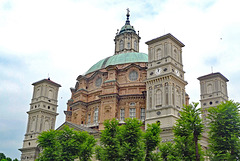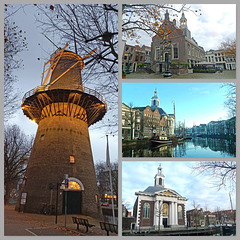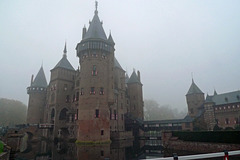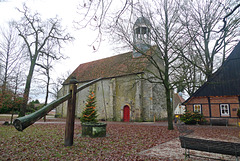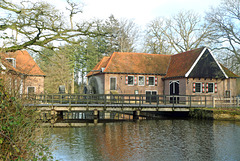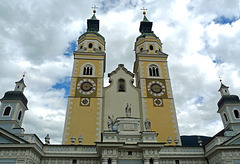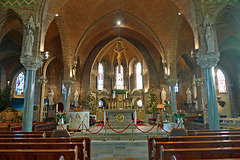Jaap van 't Veen's photos
Nederland - Oudewater
| |
|
|
|
Oudewater originated around 1100 in a meander bend where the Lange Linschoten rivulet meets the Hollandse IJssel river. The origin of the name Oudewater is not known. Most likely, it is a corruption of oude (uiter)waarden (old water-meadows). It became city rights in 1265. given by the bishop of Utrecht.
Oudewater suffered immensely during the Eighty-years war in the hands of the Spanish due to its recognition of William van Oranje as their rightful governor. The siege resulted in the murder of nearly the entire town’s population and the destruction of most of the medieval city.
After that war - during the 16th and 17th century -Oudewater rebuilt itself and prospered. Cheese and ropes were a major industry, which cultivated hemp to create high-quality ropes used for the boats sailing to Indonesia and beyond. Cheese has remained a major industry to this day, which is why the Waag (Weigh House) in Oudewater was built at the end of the 15th century.
Oudewater is well known for its Heksenwaag (Witches' scales). This Weighing house, an official town building, became famous at the height of the European witch trials of the 16th century because people accused of witchcraft were offered a fair chance to prove their innocence as opposed to many other places where the scales were rigged.
Today De Waag - with a small museum - is the main attraction of Oudewater, next to other attractive monumental buildings in its historic center.
Nederland - Schiedam, De Walvisch
| |
|
|
|
Schiedam is home to the seven largest windmills in the world. Once there were more than 30 mills in the city. The majority of the so called ‘brandersmolens’ (malt mills) ground grain for the distilleries. To catch enough wind within the built-up area, and for greater storage and production capacity, the mills grew to be the tallest in the world. They have been joined in this century by two new mills, bringing the total number of malt mills to seven. These remaining ‘Giants of Schiedam’ are still characteristic of the city.
De Walvisch (The Whale) is one of the ‘Giants of Schiedam’. The mill was built in 1794 and the foundation stone-layer was distiller A. Nolet. The mill was named after the Greenland whaling industry that flourished in the late 18th century.
Around 1900, the mill lost a piece of inner rod during a storm; it took eight months before it had four sails again. In 1928, it was sold to the then young association De Hollandsche Molen from Amsterdam. In December 1938, there was a fire in De Walvisch.
In 1996 De Walvisch burned down due to a short circuit. Only the rump of the mill remained standing. Thanks to many actions by Schiedam companies, institutions and citizens, the restoration of De Walvisch had been made possible. In 2002 it was grinding agin.
De Walvisch nowadays is owned biy the foundation Stichting De Schiedamse Molens . This foundation started a major renovation in 2017. A year later the mill became a museum, where one get to know the malt and roasting mills of the city. Fromf the stage - 17,5 meters high - there is a beautiful view over Schiedam. There is also a mill shop where one can buy flour and other baking products for instance.
Italia - Tolmezzo, Duomo di San Martino
| |
|
|
|
The Cathedral of Saint Martin ( Duomo di San Martino ) is the city’s most important religious building. The current building dates back to 1764 and stands along the main square of the town - Piazza XX Settembre - on the site of the ancient church of San Martino, which was demolished to make way for the new church designed by Domenico Schiavi from Tolmezzo. The facade was completed only in 1931.
The interior of the cathedral is well-proportioned with side chapels and a high altar of white marble . The ceiling has three frescoes, dating back to 1764. The side altars are adorned with beautiful 18th century paintings.
On the main picture you see the tomb of Saint Hilary (Sant’Ilario), patron Saint of Carnia (a mountain area in Friuli-Venezia Giulia). Every year in August (usually the first Sunday after 15th August the mortal remains of the Saint, will be moved to the little chapel of "Sant'Ilario and Madonna della Strada" outside the center of Tolmezzo. For the entire period in which it remains, usually three days, every evening the holy rosary is recited. After that period, the mortal remains will be move again at the Cathedral with a religious procession and remain exposed for a few days. So we were quite lucky to come across this tomb.
Nederland - Delft, Oude Kerk
| |
|
|
|
The Oude Kerk (Old Church) - the oldest parish church and oldest building in Delft - was officially founded in 1246 (the same year in which Delft received city rights by count Willem II), even though it is generally assumed that there had been a wooden church on this site as early as 1050.This church was originally known as Sint Bartholomeuskerk . In the middle of the 13th century, the earlier building had been rebuilt and extended by “Bartholomeus van der Marde”.
The gothic tower, with its brick spire and four angle towers, was added between 1325 and 1350. Throughout the ages, the leaning tower, probably built on an early filled-up canal, has been the cause of considerable alarm to many inhabitants. In 1843, the City Council of Delft, fearing the collapse of the tower, decided that it had to be pulled down to the level of the church roof. Local contractors were able to prevent this decision from actually being carried out. Nowadays, the leaning tower of the Oude Kerk is a prominent landmark of Delft, fondly called by the citizens the Scheve Jan (Leaning Jan).
The precious interior including the elaborately crafted stained-glass windows had been completely destroyed by the iconoclasts of 1566 and 1572. Only the beautifully carved pulpit from 1548 has survived.
Approximately 400 people are entombed in the Oude Kerk; among them a lot of wellknown Dutch historical figures, like the painter Johannes Vermeer, naval heroes Piet Hein and Maarten Tromp and scientist Anton van Leeuwenhoek (PiP5).
Nederland - Schiedam, De Drie Koornbloemen
| |
|
|
|
Schiedam is home to the seven largest windmills in the world. Once there were more than 30 mills in the city. The majority of the so called ‘brandersmolens’ (malt mills) ground grain for the distilleries. To catch enough wind within the built-up area, and for greater storage and production capacity, the mills grew to be the tallest in the world. They have been joined in this century by two new mills, bringing the total number of malt mills to seven. These remaining ‘Giants of Schiedam’ are still characteristic of the city.
De Drie Koornbloemen (The Three Corn Flowers) is a stone windmill, which was built in 1770. It is the eldest of the original malt mills in Schiedam and is the only one with a miller’s house, dating back to 1832.
In the early 19th century, the mill was used for sawing mahogany and a few years later for peeling rice. In 1857, the grinding tax was lifted. The owner then decides to start grinding for bakers again. Later millers started grinding peas, maize and beans for processing into cattle feed.
The municipality of Schiedam bought the mill in 1976. After a substantial clean-up, carried out by Schiedam mill volunteers, restoration could begin. In 1999, the miller house was completely restored.
Italia - Pontebba, Santa Maria Maggiore
| |
|
|
|
The historically most important church in the area is the parish church of Santa Maria Maggiore in Pontebba. The little chapel - most probably from the 12th century – was rebuilt in gothic styli in 1504 by architect Johann Komauer. A number of changes and additions had been made over the years. The present church - originally San Antonio Chapel - was built in 1697.
The highlight of the church is its famous ‘Flügelaltar’ (winged altarpiece). This wonderful wooden altar dates back till 1517, with carved, painted and gilded parts. The altar reproduces the incoronation of the Virgin Mary in the central scene and on the side doors at the front, evangelic scenes. The winged altarpiece has a height of 7,50 meters.
Nederland - Delft, Nieuwe Kerk
| |
|
|
|
The city council of Delft decided to build the Nieuwe Kerk (New Church). The city already had a church - nowadays known as the Oude Kerk (Old Church) - which is why it is called the Nieuwe Kerk .
In the year of 1381, a wooden temporary building - dedicated to Mary - was first erected and a few years later a stone late Gothic cross basilica was built around it, which was dedicated to St. Ursula.
As with so many churches, construction proceeds in stages. The tower was completed in 1496, consisting of a square base, above it two octagons and an apple-shaped spire. The Nieuwe Kerk was finally completed in 1655, having already endured a devastating city fire, the Delft Thunderclap (a gunpowder explosion) and various renovations.
In 1872, lightning struck the spire again. Some three years later, the famous Dutch architect Pierre Cuypers had a new one put on it. Wit a height of 108 meters it is the second highest church tower in the Netherlands.
The most prominent monument in the church is the tomb of Willem van Oranje, the Dutch ‘Father of the Fatherland’. The mausoleum was crafted by architect and sculptor Hendrick de Keyser and his son Pieter. Since the death of Willem van Oranje, the last resting place of members of the House of Oranje-Nassau has traditionally been the family vault in the Nieuwe Kerk in Delft. The latest are Queen Juliana and her husband Prince Bernhard in 2004.
The church nowadays houses an exhibition and video presentations on the history of the Nieuwe Kerk and the Dutch royal family. The church can be visited for a fee.
Nederland - Schiedam, De Kameel
| |
|
|
|
Schiedam is home to the seven largest windmills in the world. Once there were more than 30 mills in the city. The majority of the so called ‘brandersmolens’ (malt mills) ground grain for the distilleries. To catch enough wind within the built-up area, and for greater storage and production capacity, the mills grew to be the tallest in the world. They have been joined in this century by two new mills, bringing the total number of malt mills to seven. These remaining ‘Giants of Schiedam’ are still characteristic of the city.
De Kameel (The Camel) originally was built in 1715; about 30 metres east of where the rebuilt windmill along the river Schie nowadays is located. The mill served as a malt mill until the early morning of 20 March 1865. On that day the mill lost its rods, iron shaft and cap in a storm in a storm. After a partial repair the mill served as a steam sawmill for several years. Three years later the remains of De Kameel were demolished after a fire.
Of all the mills the city has had and De Kameel was the most visible from the city centre. Rebuilding it in its original location was not feasible, as the turning basin in the river Schie was moved in 1960 to build a new access road with a bridge to the city centre. A site nearby was chosen, with the mill built halfway into the water of the Schie. After years of preparation, the Stichting De Schiedamse Molens started rebuilding the mill in November 2008.
The mill measures about 30.5 meters to the top. This makes De Kameel the smallest of the existing or rebuilt Schiedam mills. Since Saturday 14 May 2011 - Dutch National Mills Day - the rebuilt mill officially has been grinding again.
Nederland - Delft, Klaeuwshofje
| |
|
|
|
Delft is one of the cities in the Netherlands that has a number of so called hofjes . A hofje is a Dutch word for a courtyard with almshouses around it. They have existed since the Middle Ages. Characteristically, almost all are built around an inner garden.
The Klaeuwshofje is named after the brewery “In De Claeuw”. It was founded in 1605 by the Uyttenhage van Ruyven couple. Often, hofjes are founded as inheritance of his or her founder, which is not the case with The Klaeuwshofje . In fact, it was built when the couple was still alive.
The Klaeuwshofje is one of the more hidden courtyards in Delft. The houses were intended for unmarried or widowed Catholic women. After a renovation, nowadays the inhabitants have double the amount of space; an improvement over the original sizes of the houses.
Nederland - Schiedam, De Palmboom
| |
|
|
|
Schiedam is home to the seven largest windmills in the world. Once there were more than 30 mills in the city. The majority of the so called 'brandersmolens' (malt mills) ground grain for the distilleries. To catch enough wind within the built-up area, and for greater storage and production capacity, the mills grew to be the tallest in the world. They have been joined in this century by two new mills, bringing the total number of malt mills to seven. These remaining ‘Giants of Schiedam’ are still characteristic of the city.
Windmill De Palmboom (The Palm Tree) is dating back to the year of 1781. The mill was used as a malt mill for the distilleries in Schiedam. The windmill was destroyed by a fire in 1901 and after that only two floors were used as storage space.
In 1993 a restoration and reconstruction started and the stage mill was renamed De Nieuwe Palmboom . Till 2018 it was used as a mill museum. It got back its original name and nowadays functions as office space and houses a documentation center.
The windmill in the background is ‘De Noord’ - one of the highest windmills in the world - nowadays housing a restaurant.
Italy - Vicoforte, Basilica della Natività di Mari…
| |
|
|
|
The Basilica della Natività di Maria Santissima (Basilica of the Nativity of Maria Santissima), commonly called “Sanctuary of Vicoforte” is one of the most important churches in Piedmont.
The huge complex has its origins in a medieval sanctuary. The story tells that an errant shot by a hunter in the year of 1592 hit a pillar of the Virgin Mary in a shrine that happened to be very important to pilgrims, and he was so repentant that he put down his gun and raised money for the repair of the pillar.
In a few years the place became a destination for increasingly frequent pilgrimages. In 1596 Duke Carlo Emanuele I of Savoy who, in 1596, commissioned the construction of a large sanctuary, but was never finished. It was not until 1728 when construction was resumed by architect and engineer Filippo Juvarra. Above the Mannerist sandstone base, the drum was quickly built, and the dome, which was finished in 1732.
The basilica has - with more than 6.000 square meters - the largest elliptical cupola in the world, which has major and minor diameters of 36 and 25 meters. The fresco decorations were completed in 1752.
During our visit to Vicoforte, the basilica was closed. Unfortunately, we could only see (and photograph) the dome through a gate.
Nederland - Schiedam
| |
|
|
|
Schiedam was founded in 1230 when the local river the “Schie”, had a dam built on it to protect the existing polders from the North Sea. The dam brought much trade to the area, due to goods being brought to, or transported from the area, to other Dutch towns. The village quickly grew and in 1275 the village received city rights.
Large parts of Schiedam were destroyed by fire in the year 1428, due to most of the buildings being made of wood. But the city was rebuilt and again, flourished. During the 1700’s the production of jenever (gin) started. Soon there were many distilleries in Schiedam. From dozens of distilleries the jenever was traded to many parts of the world and brought great wealth to the city. The gin industry gave the city its nickname 'Black Nazareth'.
Schiedam is known for its historical center with picturesque canals, lined with former warehouses, distilleries and the tallest windmills in the world.
Nederland - Haarzuilens, Kasteel de Haar
| |
|
|
|
Kasteel de Haar (The Haar Castle) is one of the most visited castles in the Netherlands. Originally it was named Het Huys te Haer . However the current Gothic fairy-tale castle was built between 1892 and 1912 with incorporation of the large 15th century ruins of the original castle.
Kasteel de Haar was first mentioned in 1391 along a blind arm of the river Rhine. Originally the owner was a member of the “Van de Haar” family. In 1449 the castle became property of the “Van Zuylen” family through the marriage between Josyna van de Haar and Dirk van Zuylen. Several families owned the castle until 1890 when baron “Etienne van Zuylen van Nijevelt”, inherited Kasteel de Haar (by then the castle had been in a ruinous and desolate state for almost two centuries). In 1887 Etienne had married the French baroness Helene de Rothschild (member of the extremely wealthy De Rothschild family), which enabled him to rebuilt the castle.
In 1892 the rebuilding of Kasteel de Haar started under the direction of the well known Dutch architect Cuypers. It's his interpretation of the ‘medieval’ castle one can see today. The interior was rebuilt in a un-Dutch luxurious style, it was equipped with electricity and the former courtyard, covered with a large roof, was turned into an imprerssive central hall. The interior is luxuriously decorated with a large but incoherent collection of valuable antiques from all over the world.
In 2000 the ownership of the castle was transferred to “Stichting Kasteel de Haar”. This foundation worked to transform the place into a museum and event center. The castle has 200 rooms - although not all of them can be visited. A couple of rooms are arranged with realistic displays to show how the castle would have looked like in his days of parties. Nowadays Kasteel de Haar is (almost) open daily for visitors.
Italy - Apricale, Chiesa della Purificazione di Ma…
| |
|
|
|
The Chiesa della Purificazione di Maria Vergine (Church of the Purification of the Virgin Mary) is the parish church of Apricale. The church - built in the 13th century - is located in the heart of the centre of the perched medieval village.
The church was restored several times and today it appears in baroque style with a neo-Romanesque façade. The interior is composed of three naves divided in two rows of four pillars each. Inside the vaults, in 1904, painter Leonida Martini frescoed floral patterns and images of saints.
The bell tower of the church is remarkable with a bicycle facing upwards. This contemporary artwork of Sergio Bianco symbolizes the power of non-gravity. I must admit that I had not seen the artwork during my visit. But a photo of Nora Caracci pointed me to this unusual tower.
Nederland - Het Stift, Stiftskerk
| |
|
|
|
Het Stift - a unique place in Twente - is an age-old protected townscape nearby Weerselo. It is over 800 years since a community was founded here by ‘Hugo van Buren’. The commune was transformed into a Benedictine double monastery that housed both monks and nuns in 1152. A century later, the last monks left Weerselo, but the unmarried ladies of nobility remained.
The central building at Het Stift is without any doubt the Stiftskerk . Not only because of its size, age and religious significance, but also because it has functioned actively throughout all the centuries: in the Middle Ages as a monastery and parish church, then as Stiftskerk of the Reformed congregation. In the latter capacity, it still functions today.
Despite its use as part of a monastery and stift inhabited by nobility, the church is small and consists of one aisle only. It is probable that the walls of irregular pieces of natural stone are from the 14th century. Originally, the church was one trave longer. In 1523 a fire destroyed the church, and when it was repaired the nave was shortened and given a new front. The buttresses, the vaults and the upper parts of the wall date from this period as well.
Today, the Stiftskerk is used for weddings, concerts, funerals and church services.
Nederland - Denekamp, Watermolen Singraven
| |
|
|
|
'Singraven' is an estate near the town of Denekamp. It includes a manor, a garden, a water mill, a carriage house and a number of farmhouses. The estate offers a versatile landscape with forests, lanes, fields, meadows, marshes and the ever-present river Dinkel.
The water mill has been part of Landgoed Singraven (Singraven Estate) since 1448. The mill consists of an oil mill (no longer in operation and partly demolished, nowadays housing a restaurant), a corn mill and a saw mill. The corn mill and saw mill are still in operation and can be visited. The mill is run - mostly on Saturdays during summer time - by volunteer millers.
Watermolen Singraven is the last water-driven undershot sawmill in the Netherlands. Its water supply comes from the small river Dinkel, which rises in the town of Holtwyck in Nordrein Westfalen (Germany).
The mill has three water wheels, each with a diameter of 5.5 metres. The left wheel against the restaurant is from the former oil mill. The oil mill was demolished in the early 20th century, so the wheel is the only remaining part. The middle wheel is from the corn mill and the right wheel from the sawmill.
Italy - Brixen Cathedral
| |
|
|
|
The ‘Dom Mariae Aufnahme in den Himmel und St. Kassian’ (Cathedral of Santa Maria Assunta and San Cassiano) is the largest church in Brixen, once belonging to the powerful Principality of Brixen, nowadays the diocese of Bolzano-Brixen. Although Bolzano is currently the city of residence of the bishop, the most important church in South Tyrol is still the cathedral in Brixen.
The cathedral is dating back to the late 10th century when the main building and its annexes were erected. A fire destroyed the church in 1174. The new Romanesque-gothic building was rebuilt in the baroque style during the period of 1745 to 1755.
The cathedral’s two towers are the landmark of the city of Brixen. The interior of the cathedral is a masterpiece of historical and artistic value. Its wide domed nave is decorated with rich marble and stucco. The main altar has a very striking altarpiece, but the decorative highlight is the fresco on the ceiling.
Nederland - Denekamp, Sint-Nicolaaskerk
| |
|
|
|
The history of the Sint-Nicolaaskerk (Church of Saint Nicholas) is dating back to the year of 1276, when Denekamp was mentioned as a parish for the first time. The church is one of the few religious buildings erected in the region of Twente in the 13th century that is still largely preserved.
The medieval part of the present church consists of a single-bay. As far as this region of the Netherlands is concerned it is the oldest preserved single-bay church, though no longer completely intact.
The medieval parts were built of sandstone from nearby Bentheim. The tower was built against the church in the second half of the 15th century (or early 16th century). Later there were many more enlargements, the last one started in 1910 with the construction of a new transept and choir and apse, which were built with bricks. Architect ‘Te Riele’ also gave the tower - which had been fully closed - an entrance in a pseudo-Romanesque style.
After the reformation the church was used by the protestant minority for about two centuries. In 1809 King ‘Lodewijk Napoleon’ gave back the church to the Catholics. The church is still used for services.
Jump to top
- ipernity © 2007-2024
- Help & Contact
|
Club news
|
About ipernity
|
History |
ipernity Club & Prices |
Guide of good conduct
Donate | Group guidelines | Privacy policy | Terms of use | Statutes | In memoria -
Facebook
Twitter











